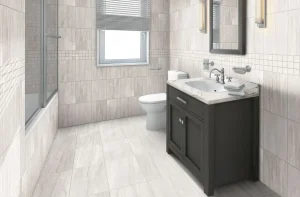Exploring Different Types of Home Flooring Materials

Flooring materials have an immense effect on how a room feels. Softer materials such as cork and vinyl provide comfort underfoot, which works particularly well in spaces where people spend long amounts of time such as kitchens or playrooms.
Wood flooring provides an elegant natural aesthetic that complements any architectural theme, while being easily refinished to address wear and tear. It is also suitable for basement environments.
Hardwood
Hardwood flooring is a timeless choice that adds natural charm and durability to the home. Available in various wood species and stain options, hardwood can easily complement both style and budget requirements while being resilient enough to withstand everyday wear-and-tear.
Oak is a timeless hardwood flooring choice, renowned for its golden tones and caramel hues that create warm environments. Additionally, its 1450 Janka hardness rating makes it suitable for homes with children or pets.
Walnut hardwood flooring has become increasingly popular due to its striking hue and textural features that complement classic and contemporary styles alike. Like oak, walnut also scores 1450 on the Janka hardness scale for durability; cherry and maple floors are other popular hardwood floor choices.
Cork
Cork flooring has been around for 75 years, yet only recently made waves as an eco-friendly flooring choice. Harvested from bark of cork oak trees (Quercus suber) found throughout Mediterranean countries, cork cellular structure contains over 50% air while Suberin provides an outstanding barrier to liquid penetration.
Cork’s same composition gives it its sound-absorbing properties, creating a quiet yet spacious acoustic environment suited for bedrooms, kids’ rooms and offices – great places where sound absorption or isolation are desired.
Cork flooring can act as a natural insect repellent while simultaneously acting as an energy saver by providing insulation between hot and cold environments, helping lower energy bills. Like linoleum and wood floors, cork’s softness allows it to resist scratching from heavy furniture without scratching itself; its flexibility also protects it against heavy furniture impacts without cracking. Cork does lighten when exposed directly sunlight though this effect can be mitigated with UV blocking films or finishes; once sealed correctly however, its stain resistance remains. It also resists staining while not absorbing moisture if sealed properly – ideal for heavy furniture loads!
Linoleum
Linoleum may bring back childhood memories of hospital floors or school cafeterias, but this classic material is making a comeback in homes today as an affordable yet eco-friendly flooring material that looks good enough for living rooms and kitchens alike.
Linoleum flooring is comprised of natural ingredients like linseed oil, cork powder, pine rosin, wood flour and ground limestone, produced in sheets or tiles and planks form. Sheets generally require professional installation while tiles and planks feature an interlocking tongue-and-groove joining system that allows it to float over subfloors without adhesives similar to vinyl and laminate planks.
Bob Vila reports that linoleum flooring is an economical, long-term investment with many advantages, including ease of maintenance and resistance against mold, mildew and bacteria growth. While its benefits make linoleum an attractive choice, prolonged exposure to standing water or high levels of humidity could cause warping or swelling over time.
Vinyl
No matter if you have been living in your home for years or just moving in, new flooring can make a dramatic difference in any room’s decor. From bedroom floors and bathroom tiles to kitchen flooring options and more, finding the ideal material can make all the difference in how each space feels and looks.
Synthetic materials like vinyl flooring are easy to care for and inexpensive to purchase, offering great versatility when it comes to design aesthetics and ease of maintenance. Plus, moisture-proof properties make vinyl ideal for moisture-prone rooms like laundry and mudrooms where other flooring options might become damaged from water spillage.
Vinyl comes in several forms, from sheets and tiles (LVT), to click versions that snap together easily over your subfloor, and even click versions that “float” like carpet does. Some vinyl flooring comes with moisture-protection measures like foam or felt underlayments attached for comfort underfoot; cork can also be a popular choice as an absorbing sound absorbent and eco-friendly material that works great beneath vinyl.






